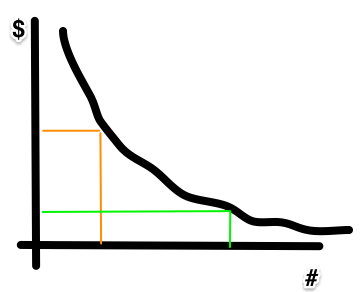Pricing is a mess. On the one hand you can argue that things should cost exactly what they cost to produce (including, of course, a pleasant lifestyle for their producers). On the other hand you can argue that they should cost exactly whatever value their users extract from the product. Surplus is the term of art. If you charge less than the value extracted the consumer is left to capture the surplus value.
More than a decade ago I had a bit of fun at the expense of my employeer arguing that we should switch all our pricing to subscription, just as Adobe has just recently decided to. My suggestion was greeted with an abundance eye rolling and head shaking.
Leaving surplus value on the table can be very risky for the producer. It’s not just about how pleasant a lifestyle he get’s (aka greed). Businesses are multi-round games; what you can invest in the next round of the game depends on how much of the surplus value you capture v.s. your competitors. But also businesses with large market share and large volumes gain scale advantages that drive down costs, establish standards, and generally create positive feedback loops. (That leads to the perverse tendency for the largest vendor to be the best and the cheapest.) Which brings us to discriminatory pricing, aka value pricing.
The demand side network effects depend on the scale of your installed base. Discounting lets you reach users that you wouldn’t otherwise. If you can segment your market then you can enlarge it. There is a standard text book illustration for this.
That chart shows the number of buyers your product will have if you charge various prices, or looking at it another way it’s showing you how much value users think they will get from your product. If you’d like a lot of users you should charge the green price. Your total revenue is, of course, the volume of the rectangle. Why not both? Why stop there? As a vendor, what you’d love charge everybody exactly what they are willing to pay. You could have both the maximum number of users and all the volume (revenue) under that curve.
Subscription pricing gives you a tool, because it lets’ you meter usage, that can stand in as a proxy for the value the users are getting from the product.
I was surprised by Adobe’s subscription pricing, not because it’s expensive and draconian. No, I was surprised because it appears to have no metering. My insta-theory for why? Well I think what we are seeing at this stage is the classic: e.g. “list price.” That they will start offering various discounted variations on the service. It would be odd if they don’t. Because, otherwise, they are leaving two things on the table. They are shunning a huge pool of users, missing out on all the demand side network effects they create, and encouraging competitors to fill into that abandoned market segment. And, they are leaving money on the table.
I’ve no idea what they will meter, but I’d be surprised if they don’t.

Maybe it doesn’t matter what they meter, as long as they do it with a straight face. I’m reminded of Keynes’ crack that the government should just bury packets of money all over the place and tell folks to dig it up. What money does, is obvious. What it means, is a puzzlement.
Thanks for the provocative yet crystal-clear article.